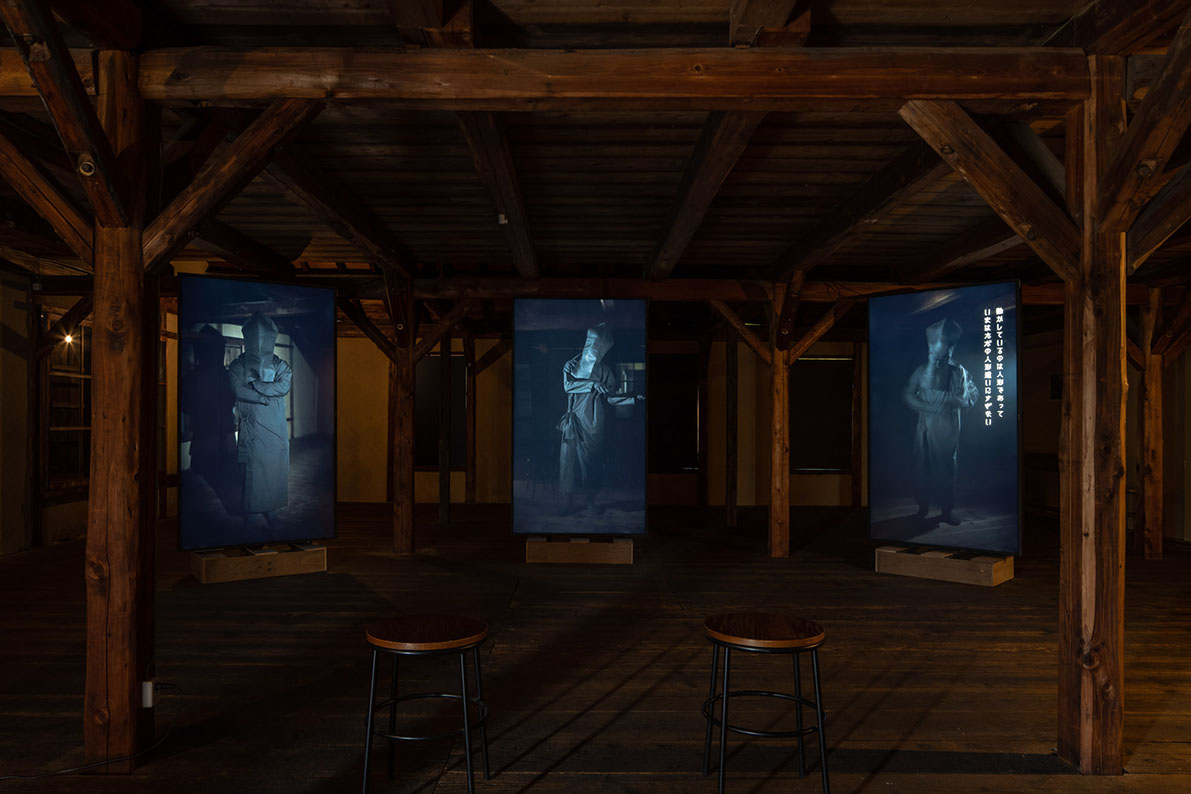ARTISTS
Tamura Yuichiro
- Born 1977 in Toyama, Japan.
- Based in Kyoto, Japan.
TK08
Tamura Yuichiro imagined this space in a renovated former bonsai pot factory warehouse as the area below a stage, with a Ningyo Joruri-style puppet play on the theme of the Plaza Accord being staged on the upper floor. Ningyo Joruri is renowned for Bunraku, one of its popular styles.
Among the ceramics industries that have contributed significantly to Aichi Prefectureʼs economic development since before World War II is the manufacture and export of ceramic dolls from Seto and Tokoname. Sales of these novelty items peaked from the late 1970s to the early 1980s, according to a comprehensive review of various data.* The ceramics export industry, which expanded due to the US-guided depreciation of the yen, was subsequently impacted by the exchange rate between the US and Japan. As the yen appreciated from its weakest point, when it hovered at approximately 200 yen to one US dollar, the cost of production and export became untenable, and the novelty doll industry in Seto and Tokoname fell into decline. Some moved their kilns to Asia while others closed them down altogether, but the dolls remain enduringly popular, especially among enthusiasts and researchers.
In this context, Tamura hypothesizes that the decline of novelty dolls was triggered by the Plaza Accord, concluded at the Plaza Hotel in New York in 1985. The drama of the Plaza Accord unfolds as a Ningyo Joruri-style puppet play based on the idea that the outcome of this agreement among the finance ministers of the five countries (Japan, the US, the UK, France, and West Germany) affected everything from the global economyʼs cycles of inflation and deflation to the fate of local industries in Aichi Prefecture. Tamura casts the economists Adam Smith, Karl Marx, and John Maynard Keynes as puppet masters dressed in black (in the manner of Ningyo Joruri puppeteers) who manipulate the characters behind the scenes. Thrilling questions emerge as to what is kept “Still Alive” by the invisible hands of these three presences today.
Tamura held a solo exhibition in New Zealand in 2019, and has worked and exhibited at venues in Japan and overseas including the 2019 Asian Art Biennial at the National Taiwan Museum of Fine Arts, Roppongi Crossing 2019: Connexions, Mori Art Museum (Tokyo), and the Busan Biennale 2018 (South Korea).
* According to documentation provided by the Seto Novelty Culture Preservation Society.
- Selected Works & Awards
-
- 2020
- Yokohama Triennale 2020 (Japan)
- 2019
- Milky Mountain (solo), Govett-Brewster Art Gallery, New Plymouth, Aotearoa New Zealand
- 2019
- 2019 Asian Art Biennial, Taichung, Taiwan
- 2018
- Hell Scream (solo), Kyoto City University of Arts Art Gallery @KCUA, Japan
- 2018
- Busan Biennale 2018, South Korea
- 2014
- SeMA Biennale Media City Seoul 2014, South Korea
Exhibition
Invisible Hands, 2022
Duration of video: 21minutes
TK08

- Installation view at Aichi Triennale 2022
- Invisible Hands, 2022
- Photo: ToLoLo studio
- Open
- 10:00-17:00
*Last admission 15 min before closing time
- Closed
- Wednesdays
- Venue / Access
- TSUNE ZUNE
- 15 minutes on foot from Tokoname Station on the Meitetsu Nagoya Line / Tokoname Line.


![STILL ALIVE Aichi Triennale 2022, July 30 (Saturday) to October 10 (Monday, public holiday), 2022 [73 days]](/2022/en/img/title-logo-date-en.svg)
